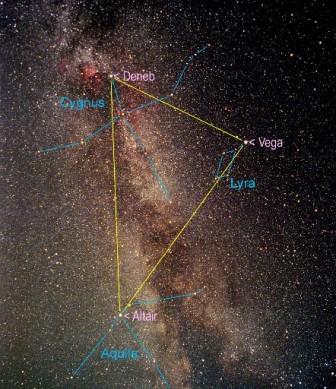one reason that so many star patterns have different interpretations from various human cultures all over the world, is that our eyes are extremely good at recognizing patterns... especially those that form simple geometric shapes. orion is one of the most easily recognizable constellations in the sky because of the straight line formed by the three stars that form his belt, or depending on your culture, these three stars form the magi, the saucepan, the shepherd of anu, shen, the long sash, etc.... there are probably many more interpretations out there that you all are familiar with and i am not!! orion appears just before dawn in the southeast right now. it will be visible for more of the night as winter approaches.

another simple geometric form and easily recognizable shape is a triangle. the moon is two days after full and still illuminating the sky, but the summer triangle is easily visible right now! almost at the zenith (directly overhead) for many is the bright star vega. this is the brightest star in the summer triangle constellation which consists of deneb to the northeast and altair to the southeast. since most of us cannot clearly see the milky way galaxy where we live, the summer triangle will be much easier to identify than this picture would lead you to believe... but i thought it was a cool shot and wanted to display it!!

next, our eyes recognize a huge square low in the east. the great square of pegasus... one of the largest constellations in the northern sky! from the sky map below, you can find the square, follow the left corner star to see the streamers flowing behind the kite (or however you want to interpret it)... and try to find andromeda! this massive neighboring galaxy should be easily visible with binoculars, but maybe not with your eye until the moon shine decreases next week.

happy hunting!
2 comments:
Nice article. I thought your comments on pattern recognition were well constructed and may have been even better if you had explained more about the stories behing the anthropomorphism of the asterisms we can see in the northern hemisphere. Enlightening all the same.
Orion is a great one to highlight and maybe include some star hops to Casseopia and the deep sky elements around that asterism. The Summer Triangle is of course a relative new comer having been coined by Patrick Moore in the '50s and isn't officially recognised as a true asterism, but the magnitude of the stars that make up the triangle are so bright that even city dwellers like myself have an opportunity to view them with the naked eye.
I hope you don't mind but I've added you to my blogroll so I can keep an eye on what's written here. I'm always big on getting amatuers (or at least trying) to write something fascinating and move the science on a notch.
thanks for your constructive feedback and adding me to your blogroll! both are much appreciated!
i wrote this piece mostly to point out the most visible asterisms in the northern sky right now, but then got to thinking about why they are so easily recognizable.... maybe i'll write more soon on the different stories behind the constellations. good suggestion!
Post a Comment